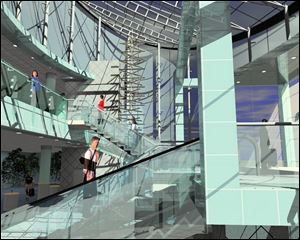
Toledo Express renovation plan draws on the 'Glass City' theme
3/24/2004
A rendering of the new escalator and stairway highlights the city's association with the glass industry.
A bigger upstairs waiting room, an expandable security checkpoint area, and restrooms that are easier to find are among the features of a preliminary renovation plan for Toledo Express Airport's passenger terminal.
The plan draws on Toledo's long association with the glass industry, highlighted by an elliptical, glassed-in addition that consultant Reynolds, Smith and Hills, Inc., has proposed to house stairs and escalators leading up to the waiting room from the entry concourse.
"It's a distinctive feature that plays on Toledo's reputation as the City of Glass,'' Martin J. Wander, the consultant's vice president for aviation and architectural discipline leader, told the Toledo-Lucas County Port Authority's airport committee yesterday.
G. Opie Rollison, the committee's chairman, said the glass elements could make Toledo's airport distinctive.
"As a gateway to our community, we need to have something that reflects our community,'' He said. "Glass is a good theme. It's something we need to be recognized for.''
While Airport director Paul Toth pointed out that the plan is preliminary, Mr. Rollison said he hopes something similar could be under construction before the year is out.
As developed by Reynolds, Smith and Hills, a Jacksonville, Fla.-based architecture and engineering firm, the renovations are likely to cost about $22 million, plus a variable cost for new equipment to inspect and handle outbound baggage, Mr. Wander said. He outlined four alternatives for baggage handling, ranging from elaborate and expensive to simple and cheap but inflexible.
The first phase focused on back-office areas that would become more actively used by travelers or personnel during the second phase. The second phase would involve ex-
panding the waiting room, remodeling the existing security checkpoint and stair-escalator area, and setting up the new baggage system.
Ground-floor restrooms currently tucked off the side of a little-used portion of the concourse would be moved to a more visible spot. With people no longer allowed to meet inbound passengers in the security zone, providing a comfortable waiting area for them has become paramount, Mr. Wander said.
The plan's third phase includes more cosmetic elements, including reconfiguring the terminal's exterior wall facing the airport roadway, raising its ceiling, and adding skylights.
No new gates are proposed as part of the renovation. But Mr. Wander said the project is designed with future expansion needs in mind, with a layout that is as flexible as possible within limitations created by the existing structure.
The initial plan provides space for up to four security checkpoint lanes; the airport now has two.
Construction could be broken down into more than three phases as funding dictates, the consultant said. But if it proceeds steadily, the recommended work should take about four years to complete.